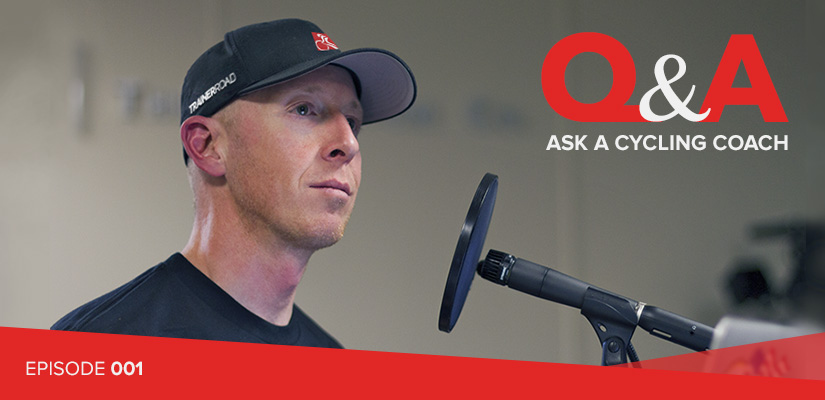Ask a Cycling Coach: 001 — TrainerRoad Podcast

TrainerRoad’s Ask a Cycling Coach podcast gives you the chance to get answers to your cycling and triathlon training questions with USAC/USAT Level I certified coach Chad Timmerman. See a few questions we answered in our latest episode below!
Listen to the Full Episode
How do I adjust my training on vacation or when I’m sick?
While training plans are precisely structured to make you a better a cyclist, life doesn’t always go according to plan. Sometimes, you’ll need to modify your training.
If you happen to take a break from training (such as a vacation), the main things to consider are the goal of your current training block and how many training sessions you’ve missed.
When you’re early on in your training in a base phase, hitting every workout precisely isn’t as crucial as it would be in later training phases — like the build phase. However, missing workouts as you get closer to your event take a much larger toll on your fitness.
If you find yourself missing 2-3 days, just pick up your training where you should be and leave those missed workouts in the past. However, if you’ve missed a week or more of training, it’s a good idea to go back to your training plan and restart where you left.
If you’ve been ill, you’ll need to take into consideration the condition of your body once you’ve recovered. Rushing into a high-intensity workout with a depleted immune system is more likely to put you behind in your fitness progression rather than move you ahead.
Go back to the rest week before you got sick and start training from there.
To hear Coach Chad’s advice on this topic, listen at 34:16.
How do my power zones relate to my heart rate zones?
VirtualPower has introduced many people to the benefits of power based-training long before purchasing a power meter, so the question of “how do my power zones relate to my heart rate zones?” is pretty common.
The answer to this depends on each athlete, and needs to be considered with a “pronounced asterisk” that references the variability of heart-rates.
Heart-rate measurement is a subjective and highly-variable lagging indicator of effort. With this in mind, using heart-rate values as data points for structuring intervals can be difficult, and defining heart-rate training zones based off max heart rate is problematic for the same reasons.
Having said that, the best way to use heart-rate training is as a reference point to power data. With time, you’ll recognize general approximations in heart-rate readings in association to specific power zones. This allows you to have a reference point when you aren’t using a power meter.
But remember, your heart rate can be influenced by many factors, so this data should be used as additional information rather than a solid data point to structure your interval workouts.
To hear Coach Chad’s advice on this topic, listen at 2:30.
Why is my power output lower on the trainer?
Many cyclists—when being introduced to indoor training— realize they can’t seem to output the same power levels they did when riding outside. There are plenty of theories about this discrepancy, but know that as your experience with indoor training grows, your outdoor riding abilities will rise as well.
The first thing to consider is your trainer. Many trainers have an unrealistic resistance curve, making your ride feel unrealistic and with too much drag.
Secondly, your body is dedicating nearly 75% of its energy consumption to regulating your body temperature while you train. If your training environment isn’t providing a similar environment (ventilation, temperature, humidity) to that outside then you shouldn’t expect similar results. We often underestimate the cooling effect of moving through the air at 15-20 mph, so using a good fan while you train indoors is extremely important.
Finally, the mental fortitude required to train indoors without the stimulation of riding outside or in a group can be challenging. While it is difficult to quantify the effects of boredom or lack of distractions from pain, we’ve certainly all felt them at one point or another. To combat this, having specific and reachable goals within a custom-tailored workout is a great way to keep you engaged, motivated and to take advantage of the highly-concentrated nature of trainer workouts.
To hear Coach Chad’s advice on this topic, listen at 21:25.
Additional Notes
In this week’s Ask a Cycling Coach podcast, Coach Chad answered 29 questions! You can learn more about these topics with our resources below:
- How to structure a cycling training plan
- How to use heart rate zones in conjunction with power zones
- What is the optimal cadence?
- How to avoid and deal with Burnout
- How to use Training Stress Score (TSS)
- Bike fit and proper riding position
- How to use heat training for cyclists
- How to train for a Half-IRONMAN
- Pacing strategies for endurance riders
- How to train for Cyclocross season
- How to follow TrainerRoad training plans outdoors
- Power output discrepancy between indoor and outdoor training
- How to train for Criterium racing
- Using TrainerRoad with Sufferfest videos
- Nutrition guidelines for cyclists
- How to follow your training plan on vacation
- How to become a faster climber
- Using TrainerRoad’s Workout Creator
- How to use left / right power measurement
- Using TrainerRoad with Tacx trainers
- When to bail out on a workout
- Using Heart Rate Variability (HRV) to adjust training
If you have a question that you’d like to ask Coach Chad, submit your question here. We’ll do our best to answer them on the next episode of the Ask a Cycling Coach podcast.